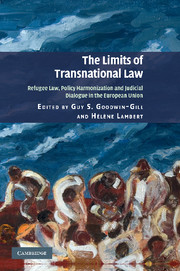 The Limits of Transnational Law
The Limits of Transnational Law Book contents
- Frontmatter
- Contents
- Notes on contributors and editors
- Acknowledgements
- Abbreviations
- 1 Transnational law, judges and refugees in the European Union
- 2 Where is the reference? On the limited role of transnational dialogue in Belgian refugee law
- 3 Transnational refugee law in the French courts: deliberate or compelled change in judicial attitudes?
- 4 The use of foreign asylum jurisprudence in the German administrative courts
- 5 The solipsistic legal monologue of Italian authorities
- 6 ‘Thou shalt not judge’ … Spanish judicial decision-making in asylum and the role of judges in interpreting the law
- 7 The British judiciary and the search for reciprocal relations with its continental partners
- 8 Speaking across borders: the limits and potential transnational dialogue on refugee law in Ireland
- 9 The absence of foreign law in Danish asylum decisions – quasi-judicial monologue with domestic policy focus?
- 10 Foreign law in Swedish judicial decision-making: playing a limited role in refugee law cases
- 11 The search for the one, true meaning …
- Bibliography
- Index
4 - The use of foreign asylum jurisprudence in the German administrative courts
Published online by Cambridge University Press: 06 July 2010
- Frontmatter
- Contents
- Notes on contributors and editors
- Acknowledgements
- Abbreviations
- 1 Transnational law, judges and refugees in the European Union
- 2 Where is the reference? On the limited role of transnational dialogue in Belgian refugee law
- 3 Transnational refugee law in the French courts: deliberate or compelled change in judicial attitudes?
- 4 The use of foreign asylum jurisprudence in the German administrative courts
- 5 The solipsistic legal monologue of Italian authorities
- 6 ‘Thou shalt not judge’ … Spanish judicial decision-making in asylum and the role of judges in interpreting the law
- 7 The British judiciary and the search for reciprocal relations with its continental partners
- 8 Speaking across borders: the limits and potential transnational dialogue on refugee law in Ireland
- 9 The absence of foreign law in Danish asylum decisions – quasi-judicial monologue with domestic policy focus?
- 10 Foreign law in Swedish judicial decision-making: playing a limited role in refugee law cases
- 11 The search for the one, true meaning …
- Bibliography
- Index
Summary
Introduction
German jurisprudence is marked by a long tradition of protection for refugees. The 1949 Constitution (or Basic Law) for the Federal Republic of Germany, known as the Grundgesetz (hereafter GG), adopted a fundamental right to asylum in Article 16, paragraph 2, section 2. Its short wording states: ‘Persons persecuted on political grounds enjoy the right of asylum.’ In 1952 Germany ratified the European Convention on the Protection of Human Rights and Fundamental Freedoms of 4 November 1950. The Convention was enacted by the National Transformation Act of 7 August 1952. In 1953 Germany ratified the Convention Relating to the Status of Refugees of 28 July 1951 (hereafter Refugee Convention). The treaty was enacted by the National Transformation Act of 24 December 1953.
Only nine months prior to the entry into force of the above legislation, the first statutory order concerning the recognition of refugee status in accordance with the Refugee Convention had been enacted. The GG, however, did not incorporate a recognition procedure for refugees wanting to apply for the right to asylum. The procedure as such was overseen by civil servants of the Federal Ministry of the Interior. In 1965 this statutory order was replaced with the first Aliens Act. The new legislation included a recognition procedure not only for refugees in the sense of the Refugee Convention but also for ‘other foreigners’. The Refugee Convention had previously only been applicable to those whose well-founded fear of persecution arose by reason of events occurring before 1 January 1951.
- Type
- Chapter
- Information
- The Limits of Transnational LawRefugee Law, Policy Harmonization and Judicial Dialogue in the European Union, pp. 57 - 84Publisher: Cambridge University PressPrint publication year: 2010
